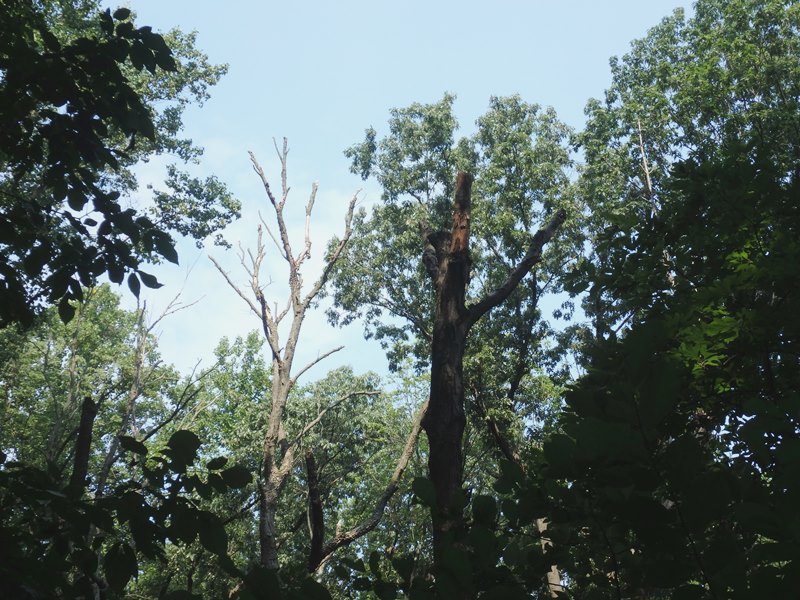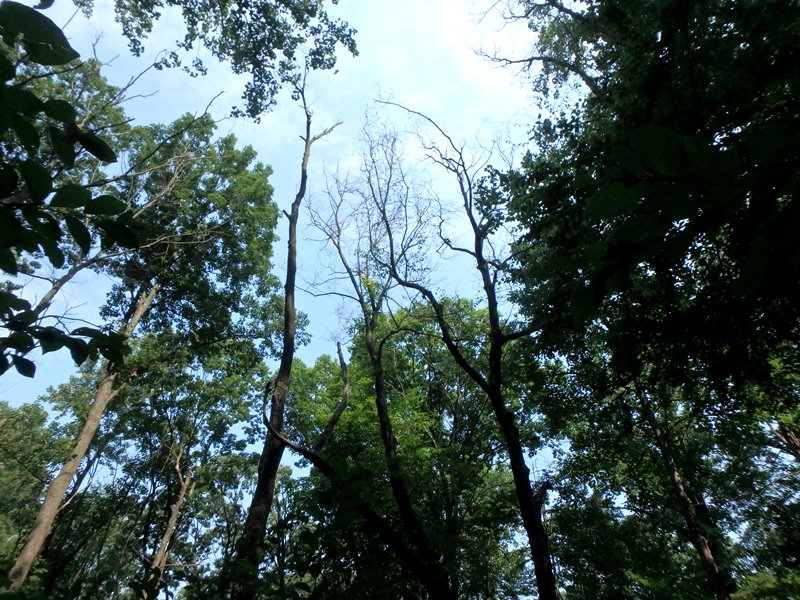Mariton: Black Birches
by Tim Burris, Preserve Manager

Dead black birches in the forest.
A few years back I noticed some of the Black Birch (Betula lenta) trees were dying in Mariton’s forest. There were patches of 3 – 4 mature trees that would suddenly die. What seemed strange was that there were several other birch trees next to the patch that seemed healthy. I considered that perhaps the trees weren’t getting enough sunlight, but I had trees die on the edge of a meadow with lots of sunlight. I considered insects or disease, but the patches stayed relatively discreet and nearby birch trees remained healthy. I considered age, but there were several trees in the forest of similar girth that were doing quite well.
I did some tree disease research, asked colleagues, and tried some other avenues. Birch trees are generally free of diseases, so I just figured it was some anomaly. I continued to monitor the patches and look for answers.
A chance meeting with a Service Forester I met many years ago led to an introduction to Kendra McMillian at Pennsylvania’s Bureau Forestry. She is the Forest Health Specialist for the entire eastern half of Pennsylvania. We had phone and email conversations and her interest was piqued enough to organize a field trip along with two tree pathologists from the Bureau. When she arrived at Mariton, we realized that we had met several years ago when she had served as Dan Barringer’s intern at Crow’s Nest Preserve. (I thought her name rang a bell.) Natural Lands has many interesting tendrils.
When the pathologists arrived, one of them asked if the birches could be just reaching the end of their lifespan. I said I had considered that, but the patchiness had led me away from that conclusion.

Dead black birches, with other tree species in the forest.
We hiked around the property and looked at the different patches. They examined and cut into the dead trees looking for signs of insect damage or disease. Nothing revealed itself. We even found a few trees that had recently died, and again no smoking gun.
As we looked at all the healthy trees next to the dying patches one of the pathologists mentioned genetics of individuals. I gave myself a dope slap. I talk about genetics all the time on tree walks. You can find trees of the same species next to each other that are very different in diameter but the same age. Since until recently, forest management in Pennsylvania was to cut everything at once, we have what are referred to as “even-aged forests”. All the trees in that forest are basically the same age, even though they might be different sizes (genetics). As time goes on, storms and other events may open up sections of the forest allowing seedlings and saplings to thrive. Then eventually we will have “uneven-aged” forest stands, and probably more diversity for wildlife.

The green foliage on the right of this photo is from mature healthy black birch trees next to a patch that is dying out.
At the end of our hike the conclusion of everyone was that this was just a normal cycle, perhaps accelerated by climate changes or other stresses. The healthy birches are genetically different and will survive longer, but eventually they too will succumb to old age. The good news is that Mariton has a healthy understory with regenerative stock (young trees just waiting for some sunlight) that will quickly move into the openings caused by the dying birches.
